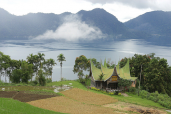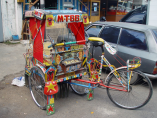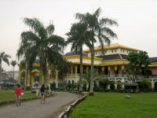introduction

MichaelJLowe: Locator map of Sumatra; 20 April 2007
Sumatera (also spelled Sumatra) is a mountainous island in western Indonesia is the sixth largest island in the world (approximately 470,000 km²) and is the largest island in Indonesia. The area of the island is 470,000 km².
surfing

Indradi Soemardjan: Lake Maninjau, West sumatra; 2005
Too much has been written on the devastation this beautiful area suffered in both the 2004 Boxing Day Disaster and then again in the 2005 earthquake event. Families, livelihoods and entire towns were destroyed. Even today there is much work to do. If surfing can contribute to realising the dream of returning the area to normality what a fantastic thing that would be. The whole area balances on a knifes edge though. Whilst agencies such as SurfAid bring medical assistance to thousands, the northern areas of Sumatra in Banda Aceh still bear the scars of decades of civil rights abuses.
If you come here to surf, be conscious of doing some good as well. This is a place to respect. Save your sexual exploits and untamed binge drinking for another port. Sumatra is home to the Mentawis, Nias, Hinakos and Telos Islands. All regions are best accessed by a professional guide / boat. A surf trip here is without a doubt a life changing experience. Not everything here is 6-10 feet breaking on razor sharp reef, a decent guide will be able to find something that suits your individual experience and ability, ideally ramping things up on your final days to really give you some memories to take home with you.
Take only pictures
Leave only footprints
Catch only waves
travel

Jpatokal: Indonesia bike46; 5 February 2006
There are many ways of getting around Indo: by plane, bus, car, boat, train, ojek or becak. The last one, pronounced as "BEH-chuck", is a tricycle (pedicab) transportation mode for short distances such as residential areas in many cities. The better your communication skills are, the less you will pay and check the cost beforehand. By the way, there are no becak in Jakarta. Instead, there is the motorized bajaj (BAH-jai). In some other provinces (eg. North Sumatra, Aceh) there are motorbikes with sidecars, known as bentor (short for becak bermotor).
Ojek is motorcycle taxi, which you may want to take if you're in such a hurry that you're willing to lose a limb to get there.
Car is not the safest way to travel as well – rules on the roads are ignored, driving on the road shoulder is common, buses speed like maniacs and stop without warning, pedestrians cross the road anywhere, even across highways…and police is not doing anything about this mess. So it’s your decision, mates. Just in case you still decide to hire a car, the traffic moves on the left in Indonesia.
Not sure if you should consider bus as well…drivers are often drunk, on drugs or just reckless; keep an eye on your bags at all times and avoid overnight journeys in the wilder parts of the country (notably South Sumatra).
Travelling by plane is probably the safest option, though the safety record of the smaller companies is dubious. But the good thing is that a select a few carriers, such as Garuda, Lion Air, and Mandala among others, have recently bought brand new planes straight from an aircraft manufacturer which have replaced some of the older planes in their fleet. So the situation is a bit better, though be prepared that many carriers have poor on-time records and frequent cancellations.
Ferries are very popular and with PELNI (the largest company) you can go to practically every inhabited island in Indonesia. But as usual, safety records are poor, so look for safety devices on board and postpone your trip if the weather is bad.
Java by far has the best railway network; some parts of Sumatra are covered as well. Journey will take quite a long time, but the scenery is a bonus. Be aware of theft and lock your doors at night.
where to stay

TheSentinel: Maimoon Palace, 3 February 2008
There are quite a few decent and inexpensive hotels in Sumatra built especially for the needs of tourists. Ranging from budget choices (Bread and Breakfast) to expensive five star luxurious hotels, there is accommodation that suits everyone’s budget.
Some recommended accommodations include:
Karang Nyimbor Hotel - accommodates up to 21 people in nine rooms (8 twin share, one 5 bed room).
Andy's House – behind Karang Nyimbor Hotel but slightly quiet. Andy’s Hotel can only accommodate 14 and can be an ideal option for groups of 5 or more people.
Ela's Camp - located next door to the Karang Nyimbor Hotel and sleeps 12. Suited for a budget conscious surfer – offering the best location for surfing at a low price.
Way Jambu – a basic camp with very limited facilities but positioned near the heaviest wave in the area.
what to pack

Fir0002: Canon-Deluxe Backpack-200-EG; 26 June 2005
There are many cities in this area, so you will be able to buy thing that you forgot at home.
But the general rule will be to take sneakers (comfortable shoes) and clothing for the tropical weather.
Definitely take along some bug repellent spray, good sunscreen and sunglasses! Getting a medical insurance for the trip would be a good idea too.
A small backpack makes a good carryon bag and will be useful in daily life. And of course, bring a camera, there're plenty of photo opportunities here to impress your mates with back home. And take a good protection for your camera from the sand.






